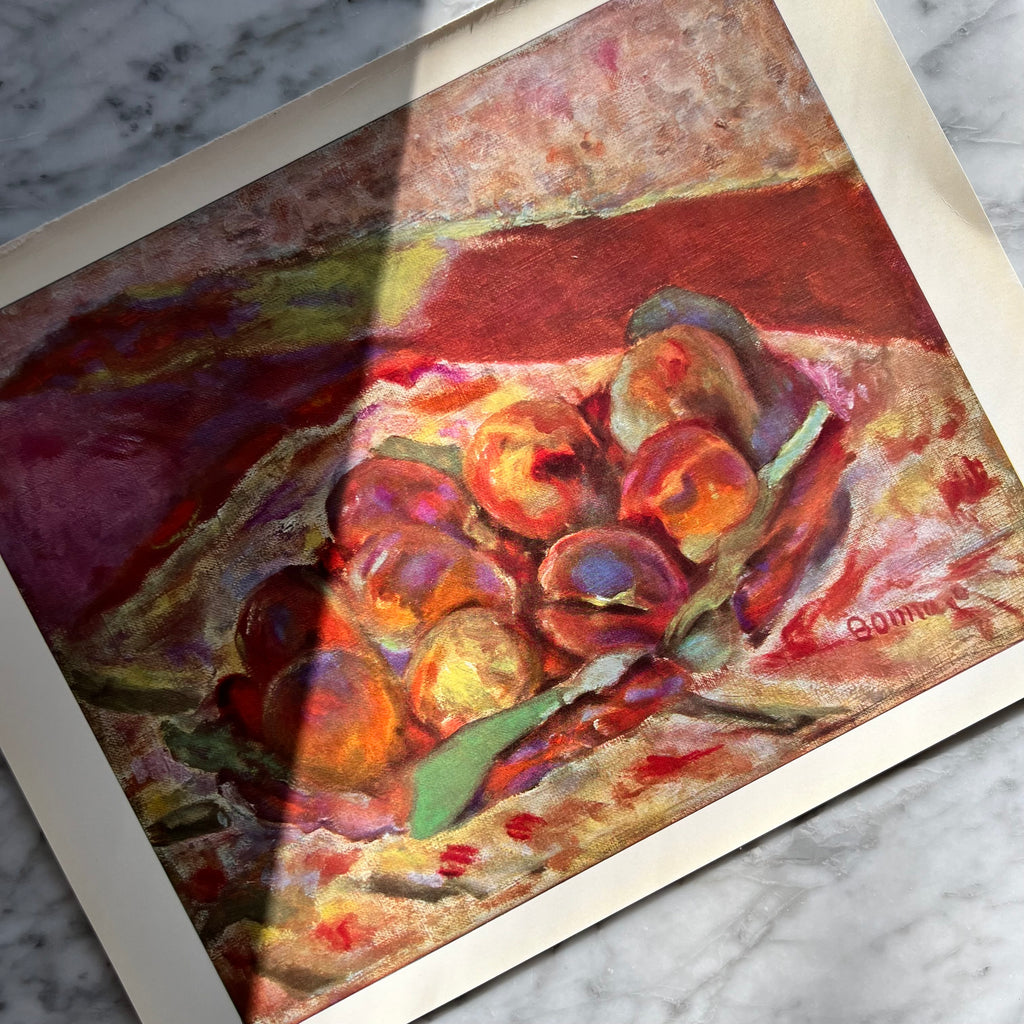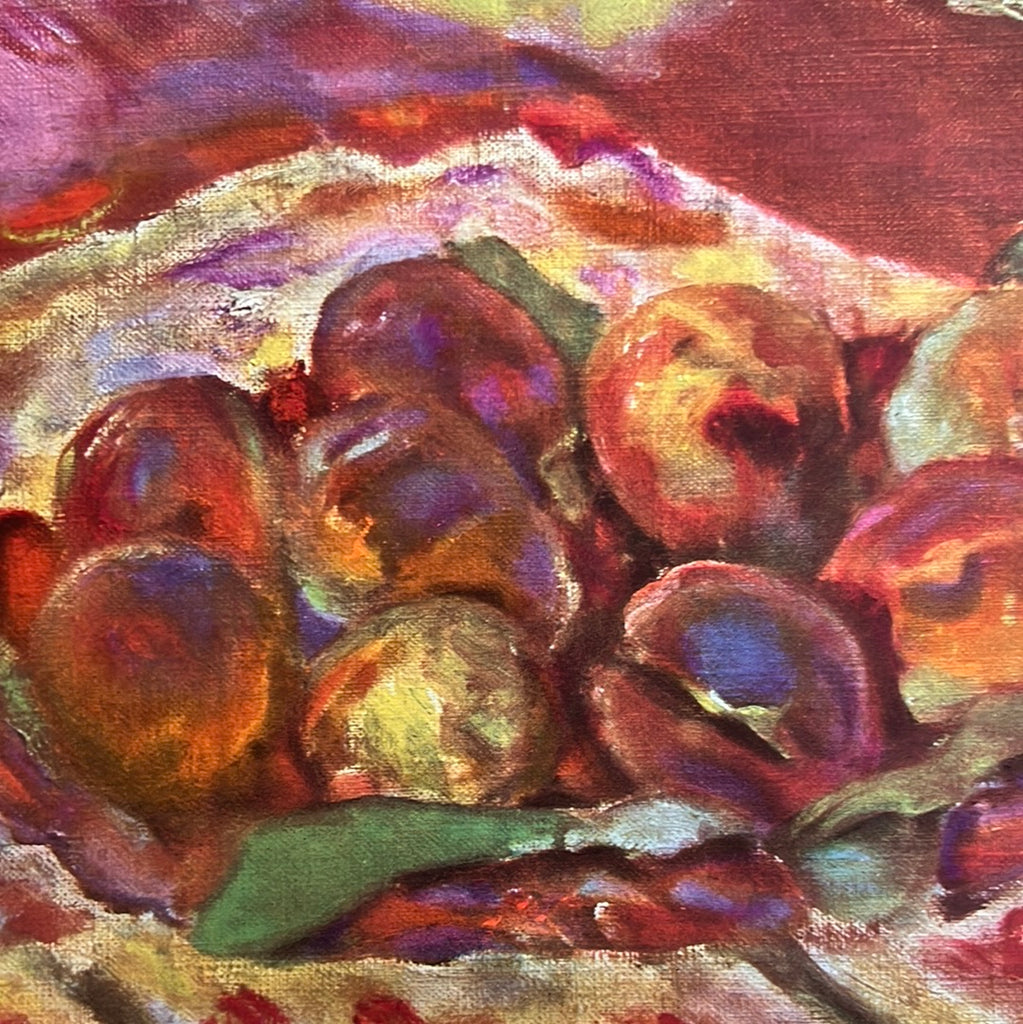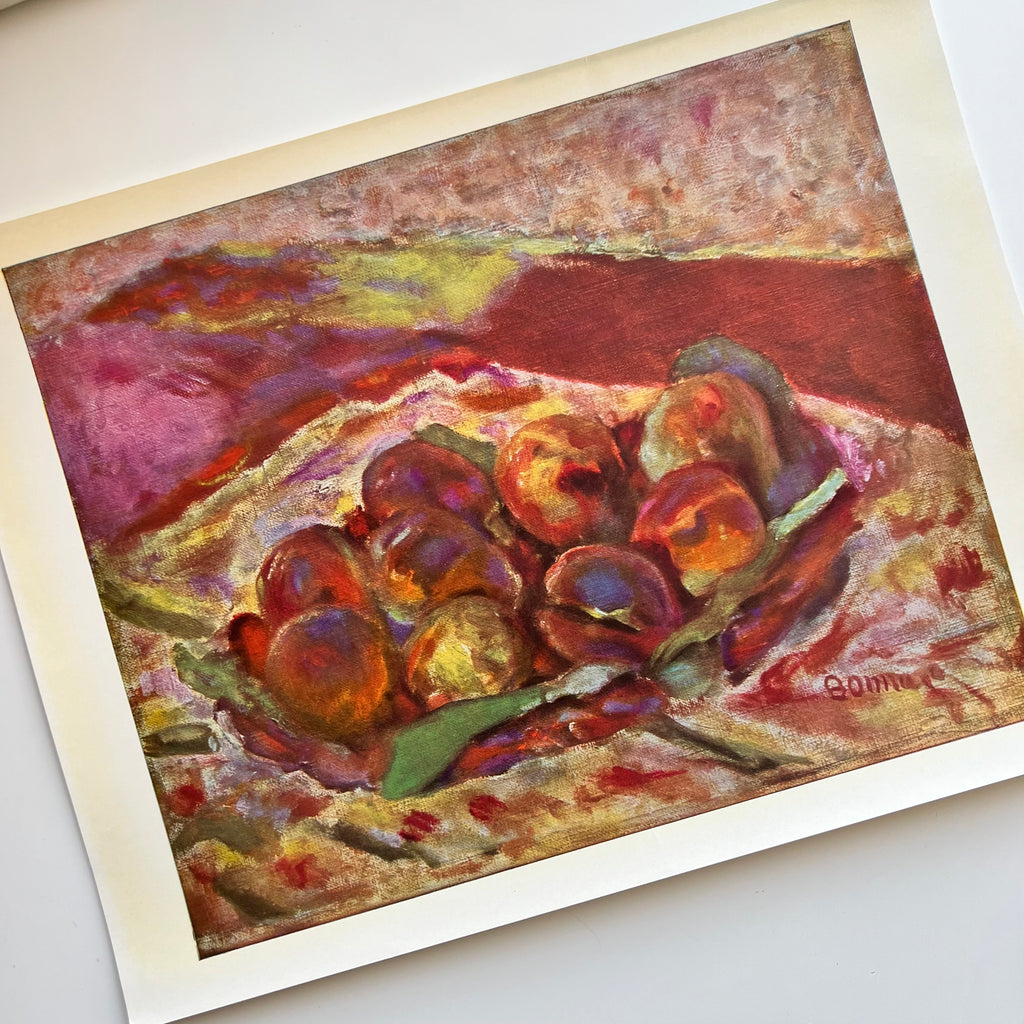Rare Vintage 1950s Bonnard “Peaches” Still Life Swiss Art Print
GOLDEN RULE GALLERY VINTAGE ARTA 12" x 9.5" Swiss art plate of Peaches (1945) by Pierre Bonnard printed on thick glossy paper with charming patina around the edges.
This still life was painted only two years before Bonnard's death. Here, close on eighty years of age, the artist displays a handwriting of sovereign freedom in a perfect unity of tone. Color, and color alone, reigns supreme in this little picture which seems to concentrate on a small surface all the heat and light of the South. At the end of his life, Bonnard's painting certainly attained an extraordinary lyrical intensity at the same time as a unity that compels our admiration. Each touch is balanced by its complementary, each accent refers to another; the whole is controlled, balanced, harmonized, to a far greater extent than is apparent at first sight.
Pierre Bonnard, who at the Lycée had shown a bent for Latin and Greck, entered law school when he was nineteen to please his father but attended the Ecole des Beaux-Arts and the Académie Jullian to satisfy his own passion for drawing. It was the year 1886, when the Impressionists held their last group exhibition, Gauguin betook himself to Brittany in search of a purer world, and Van Gogh's artistic activity was drawing to a close.
At Jullian's young Bonnard met Paul Sérusier, an enthusiastic disciple of Gauguin. With a few kindred spirits -among them Maurice Denis and, later, Edouard Vuillard and Ker-Xavier Roussel-they founded a group whose self-appointed mission was to renovate painting. It was Sérusier who gave the group the name of Nabis, from a Hebrew word meaning "prophet." From Gauguin they had learnt to "dare every-thing." That lesson and the example of Japanese prints, which Europe had just discovered, led them to adopt a decorative style characterized by synthetic linework and an arbitrary handling in which flat zones of color are enclosed by an expressive arabesque.
But Bonnard was far too sensitive and intelligent to allow himself to be imprisoned, like Gauguin, in a formula, however explosive. With his friend Vuillard he very soon threw off the shackles of that rather affected aesthetic, and from the spectacle of the Paris streets at the turn of the century learnt anew to appreciate the value of grays and half tones and restore movement to his composition. Now it was Degas and snapshot photographs that inspired his researches, while the technique of lithography and the language of posters influenced not only his paintings but a great variety of other works- stage sets, book illustrations, textile designs. During that same period Bonnard was welcomed into literary circles. At the "Revue Blanche," founded in 1891, he met André Gide, Jules Renard and Octave Mirbeau. He was also accepted by the theatrical world and, in collaboration with Sérusier, did the sets for Alfred Jarry's "Ubu-Roi." But a new phase was on its way. While still a child, Bonnard had learnt to love liberty and nature in the garden of his father's country house in the Dauphine. Now he discovered the misty loveliness of the gardens of the Ile-de-France. This marked the beginning of a long quest for light and color which he pursued from garden to garden all his life long, and which finally led him to the dazzling brilliance of the South of France that fires his latest canvases.
Just then he met Marthe, a pretty little dressmaker who became his lifelong companion and whom he married thirty years later. Happy, serene, reserved, he worked quietly and deliberately, but without a pause; his work already marked by a personality whose qualities were tenderness, sensuality and a peculiar charm. His first nudes, which clearly owe much to Degas, seem to concentrate in their blond or pearly flesh all the joy of life. About 1910 Bonnard discovered, together with the Fauves, the light of Provence, where he came in contact with Renoir. At once his palette was enriched with warmer tints, his pictures were imbued with brighter tones. Back in Vernon, near Giverny where Claude Monet was working, he used the lilting accents of the South and its bright colors to paint the cool, verdant landscapes of Normandy.
But Bonnard was never satisfied with the easy way. Confronted with the too obvious charms of those fragile harmonies, those vague spells, he passed through a phase of doubt and uncertainty. At the age of forty-five, he decided to revert to the salutary practice of drawing and strict composition. Without renouncing the joys of color, he determined once more to obey the stern dictates of form. He now sought to give his compositions the support of straight lines-the folds of a curtain, the edge of a wall, the mast of a ship, the frame of a window-dividing the canvas into cleverly arranged planes and concentrating the sky in a few curving volutes. To put it briefly, he constructed a solid architecture under the blaze of colors that burst forth from each new work.
When the Second World War broke out Bonnard withdrew to a small house he had bought in 1925 at Le Cannet on the Riviera. There his wife died in 1942. Nature was still the main source of his inspiration.
Landscapes, flowers, fruit, produced a wealth of emotions to be recorded, visions to be relished in silence and then transferred to the canvas in a profusion of tones, vibrations and meticulous touches that enchant the spectator. The sumptuous display of radiant yellows, azure blues, sour greens, triumphant oranges, is mingled with chaste pinks, elegiac mauves and lilacs, and a passionate vermilion. Every picture is a feast of color the like of which has never been seen. Yet, when his life was drawing to a close, Bonnard told the young painter Jean Bazaine: "I am just beginning to understand, I ought to start all over again." Pierre Bonnard died as discreetly as he had lived. Today one can rightly say that his death bereft the world of the greatest colorist of the age.





